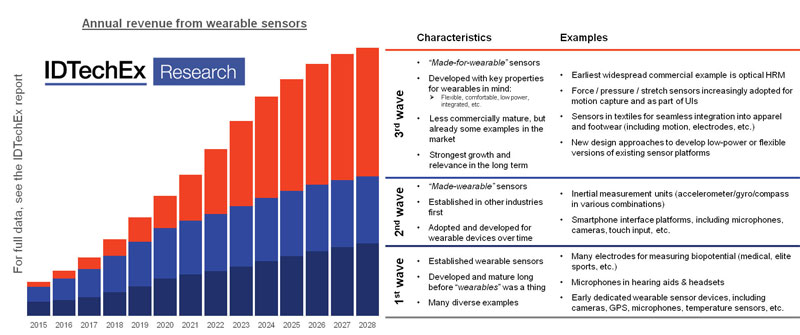Wearable sensors to reach their first billion dollar year
IDTechEx predict that 2017 will be the first billion dollar year for wearable sensors. These critical components are central to the core value proposition in many wearable devices. The Wearable Sensors 2018-2028: Technologies, Markets & Players report includes IDTechEx’s latest research and forecasts on this topic, collating over three years of work to provide a thorough characterisation and outlook for each type of sensor used in wearable products today.
Despite sales volumes from wearable products continuing to grow, creeping commoditisation squeezes margins, with hardware sales being particularly vulnerable. This has led to some consolidation in the industry, with several prominent failures and exits, and challenging time even amongst market leaders in each sector.
As hardware margins are squeezed, business models are changing to increasingly focus on the valuable data generated once a device is worn. Sensors are responsible for the collection and quality of that data, so understanding the capabilities and limitations of different sensor platforms is critical to understanding the progress of the industry as a whole.
In the report, IDTechEx address 21 different types of wearable sensor across nine different categories as follows: Inertial Measurement Units (IMUs), optical sensors, electrodes, force/pressure/stretch sensors, temperature sensors, microphones, GPS, chemical and gas sensors. Hundreds of examples from throughout the report cover a breadth of technology readiness, ranging from long-established industries to early proof-of-concepts. The report contains information about the activities of over 115 different companies, with primary content (including interviews, exhibition or site visits by the authors) to more than 80 different companies, large and small.
IDTechEx describe wearable sensors in three waves. The first wave includes sensors that have been incorporated in wearable for many years, often being originally developed for wearable products decades ago, and existing as mature industries today. A second wave of wearable sensors came following huge technology investment in smartphones. Many of the sensors from smartphones could be easily adapted for use in wearable products; they could be made-wearable. Finally, as wearable technology hype and investment peaked, many organisations identified many sensor types that could be developed specifically with wearable products in mind. These made-for-wearable sensors often remain in the commercial evaluation or relatively early commercial sales today, but some examples are already becoming significant success stories.

Billions of wearable electronic products are already sold each year today. Many have already experienced significant hardware commoditisation, with tough competition driving prices down. Even as wearable devices become more advanced, introducing more sensors and better components to enhance value propositions, lessons of history tell us that hardware will always be prone to commoditisation. As this happens the role of sensors only becomes more important; with hardware prices being constantly squeezed, increasing proportions of the value that companies can capture from products will be from the data that the products can generate.
The key hardware component for capturing this data is the sensors, so understanding the development and prospects of sensors today is critical to predicting the potential for this entire industry in the future. Wearable Sensors 2018-2028: Technologies, Markets & Players is written to address the needs of any company or individual looking to gain a clearer, independent perspective on the outlook for various types of wearable sensor. The report answers detailed questions about technology, markets and industry trends, and supported by years of primary research investment collated and distilled within.





